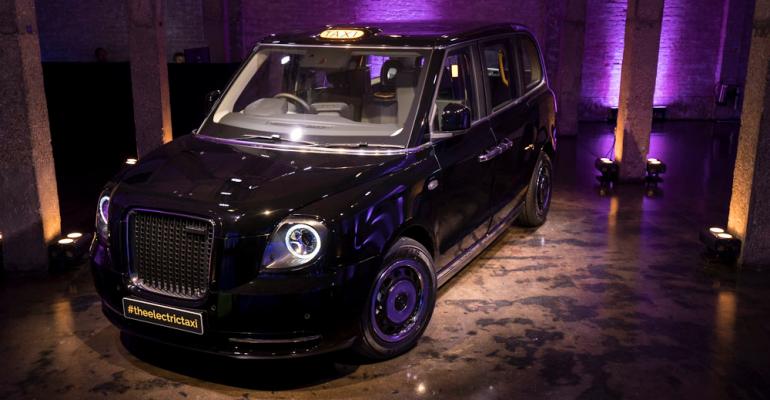The Chinese-owned London Taxi Co. relaunches as the London Electric Vehicle Co. with its new electric taxi and ambitions to be the urban commercial-vehicle provider of choice for cities around the world.
CEO Chris Gubbey says the creation of the world’s only dedicated company for the electric-taxi market and the first major international order – from the Netherlands for an initial 225 vehicles to be delivered in 2018 – is “incredibly exciting” for the wholly owned subsidiary of Chinese automaker Geely, which has invested £325 million ($420 million) in the program.
Alongside the unveiling of its new name and brand logo, LEVC also reveals the production-ready version of the new London Taxi – the electric TX – with its eCity technology comprising an advanced battery-electric powertrain and a small gasoline generator. It gives the TX a range of more than 400 miles (644 km), including 70 miles (112 km) with zero emissions.
“Drawing on the best of British design and engineering as well as technical expertise from our sister company Volvo, our products will help transform city living and provide taxi drivers with an average weekly fuel saving of £100 ($129) compared with our outgoing diesel model,” Gubbey says in a statement.
The TX will hit the streets of London later this year as LEVC finalizes its quality and a testing regime which has taken it to the extreme heat of the Arizona desert and freezing temperatures in the Arctic Circle.
LEVC expects strong demand from its launch market in London once the order book opens Aug. 1.
“London has led the way in setting out tough measures to reduce taxi and van emissions, and in just a few short years we expect EVs for the commercial operator will not just become commonplace, but mandatory in cities around the world, creating huge opportunities for LEVC globally,” Gubbey says.
The TX design gives a nod to the iconic vehicles that have operated for decades in London.
The instantly recognizable rectangular grille and circular headlights are incorporated into a more contemporary design, with daytime running lights, simplified lines and an inset chrome frame to the grille.
A rear-hinged passenger door with 90-degree opening is reminiscent of the 1930s luxury sedans that in part influenced the design of the vehicle.
The cab retains its disability-access features and offers a new, retractable integrated ramp, making it quicker and easier for drivers to load passengers in wheelchairs in a forward-facing position.
Other accessibility features include induction loops for hearing aids a well as contrasting grab handles and seat edges for the partially sighted.
Passengers will notice less vibration and noise in the passenger cabin, alongside charging points for mobile phones, Wi-Fi and space for six passengers.
The taxi is built using the latest techniques in aluminum bonding. This avoids welding or riveting, reducing the cab’s weight and completely offsetting the additional weight of the battery while maintaining vehicle strength.
The TX’s eCity technology combines a small gasoline generator, known as a range extender, with a class-leading battery and proven electric powertrain, LEVC says. With its range, a driver could take passengers from London to Edinburgh, Scotland, or Paris without stopping for fuel.
LEVC reports Transport for London, the local government body responsible for the transport system in Greater London, anticipates 9,000 London taxis will be zero-emissions-capable vehicles by the end of 2020.





